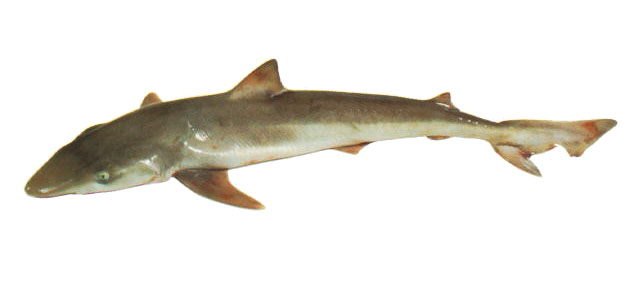| Triakidae (Houndsharks), subfamily: Galeorhininae |
| 193 cm TL (male/unsexed); 195 cm TL (female); max.weight: 45 kg; max. reported age: 55 years |
|
benthopelagic; marine; depth range 0 - 1100 m, oceanodromous |
| World-wide in temperate waters (Ref. 58085). Western Atlantic: southern Brazil to Argentina. Eastern Atlantic: Iceland, Norway, Faeroe Islands, British Isles to the Mediterranean and Senegal; Namibia to South Africa (Western Indian Ocean). Western Pacific: Australia and New Zealand. Eastern Pacific: British Columbia (Canada) to southern Baja California, Gulf of California; Peru and Chile. Questionable records in Ivory Coast, Nigerai, Gabon to Congo Dem Rep and Laysan Is. (Hawaii) (Ref 244). |
|
Dorsal spines (total): 0-0; Dorsal soft rays (total): 0-0; Anal spines: 0-0; Anal soft rays: 0-0. A large houndshark with a long, pointed snout, a large mouth, and small blade-like teeth; 2nd dorsal about as large as anal fin and terminal caudal lobe as long as rest of fin (Ref. 5578). Greyish above, white below; young with black markings on fins (Ref. 5578). |
| Mainly demersal on continental and insular shelves, but also on the upper slopes, at depths from near shore to 550 m (Ref. 6871), but has been shown to be pelagic in the open ocean (frequently caught on floating tuna longlines over deep water, and many New Zealand-tagged specimens have been recaptured in Australia) (Ref. 26346). Occurs in small schools that are highly migratory in higher latitudes in their range (Ref. 244). There is pronounced partial segregation by size and sex in some areas (Ref. 244). Feeds on fishes (bottom as well as pelagic species, Ref. 26346), crustaceans, cephalopods, worms, and echinoderms (Ref. 244). Ovoviviparous (Ref. 50449). Targeted for human consumption, liver for squalene oil, fins for soup (Ref. 244); also utilized as fishmeal (Ref. 13563). Marketed fresh, dried-salted, and frozen (Ref. 9987). Adapts well in captivity if carefully captured and handled (Ref. 12951). |
|
Critically Endangered (CR); Date assessed: 14 February 2020 (A2bd) Ref. (130435)
|
| harmless |
Source and more info: www.fishbase.org. For personal, classroom, and other internal use only. Not for publication.
